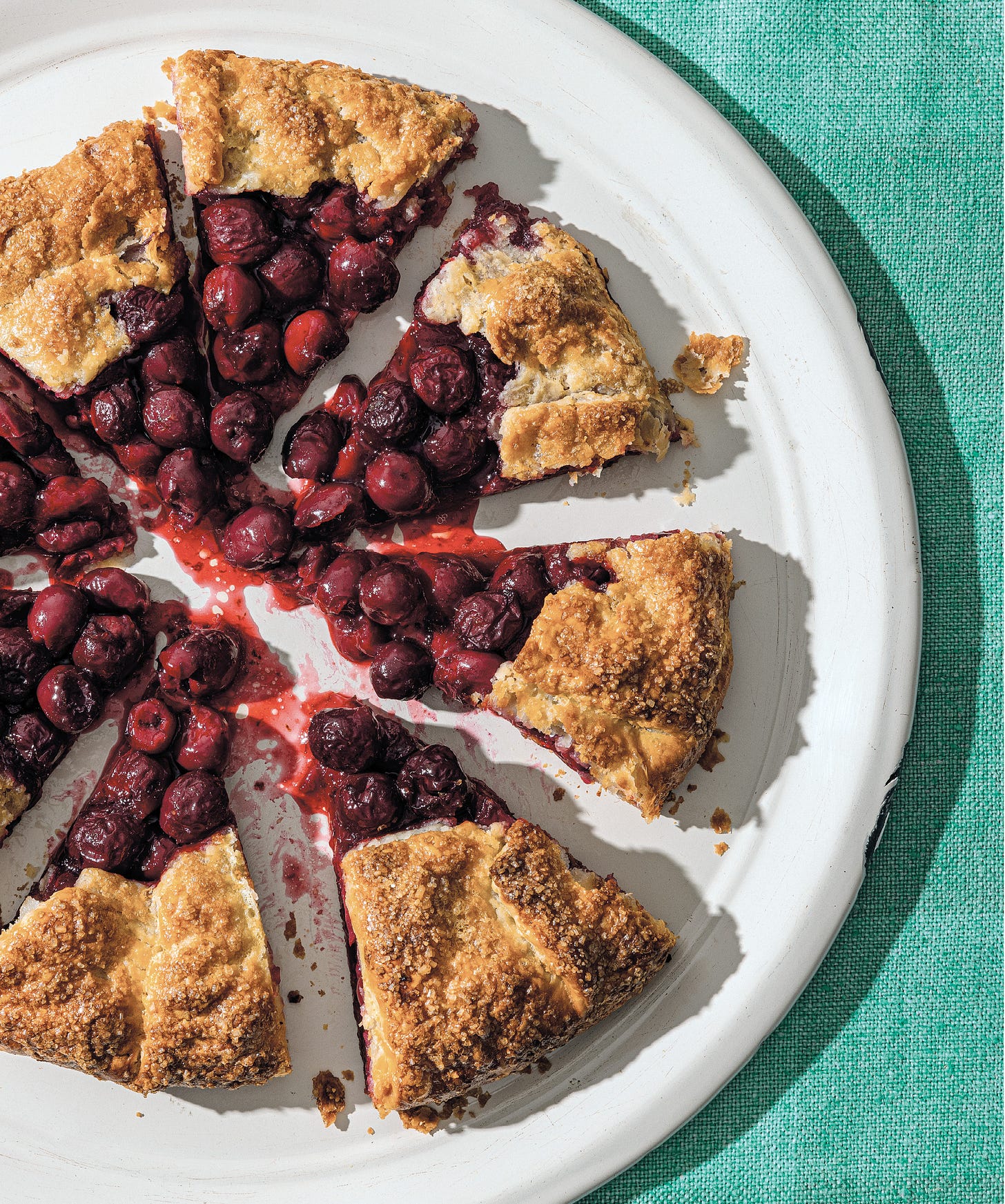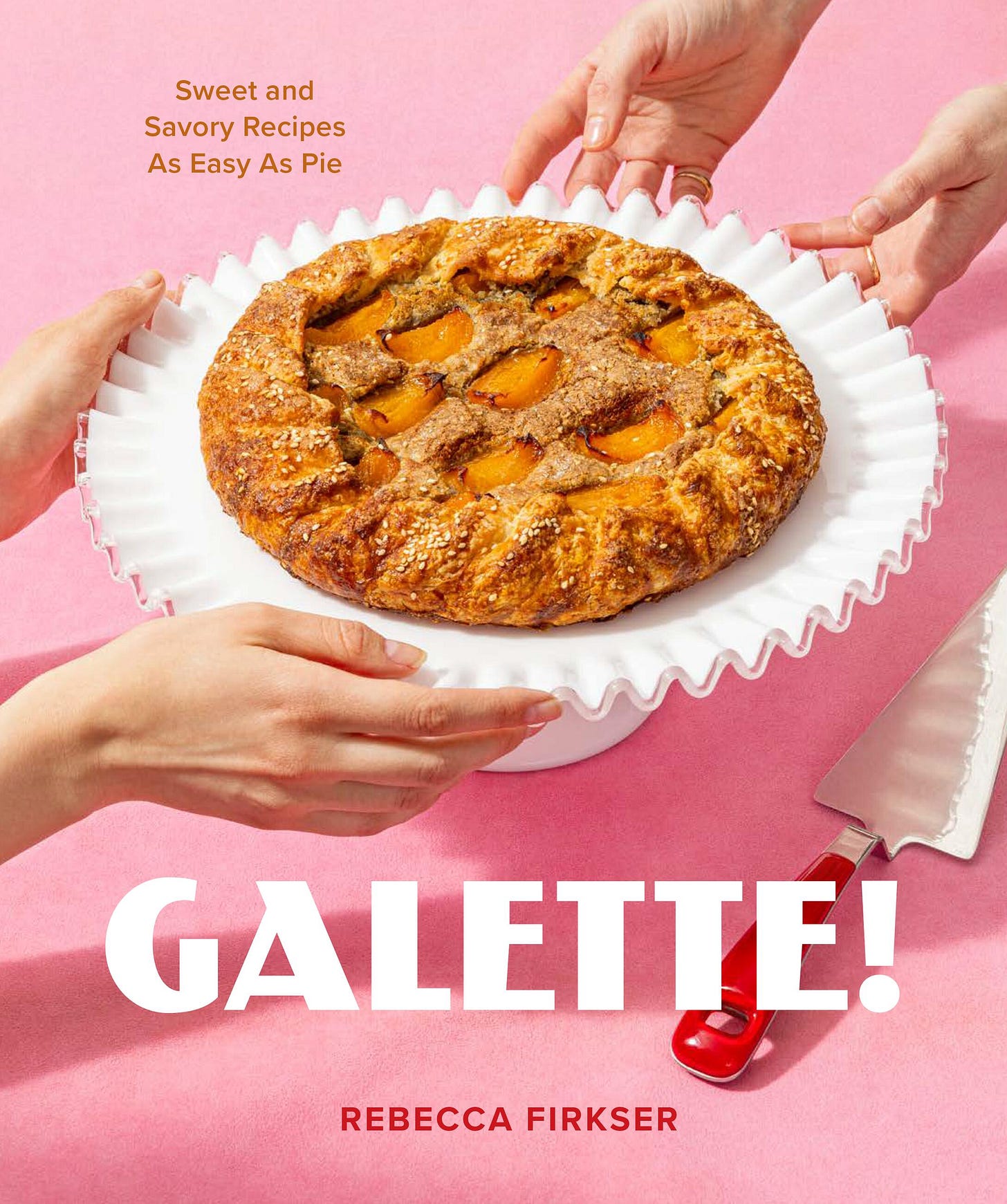Every cookbook season there’s a handful of books that I particularly look forward to receiving. That excitement is only amplified when I know the author behind the book and have been on the (metaphorical) journey with them. Just in time for summer, my friend Rebecca Firkser’s first book Galette! is at the top of that list.
Rebecca and I met while she was my editor at Food52, and somewhere along the lines parlayed that relationship into a real-life friendship. Since going freelance, Rebecca launched her own newsletter called Nickel & Dine, which focuses on budget-based recipes that deliver big flavors, has ghost written a handful of books, and most notably, has written her own debut cookbook.
As a long-time galette lover and fan of everything Rebecca makes, I’m so into this book. While there are of course recipes that highlight your favorite stone fruit, zucchini, and tomatoes, what I love about Galette! is all the unexpected flavor combinations Rebecca offers. There’s both sweet and savory options, multiples types of doughs, shapes, and crimps. Read on for an interview with Rebecca and to get her recipe for a very summery Sweet Cherry and Lime Galette.

Rebecca, I'm so excited to have Galette! in hand! We've been talking about the process of creating books for, well, years, but I'd love to start off with hearing how this book came to be.
Thank you so much!! This book came to be in a somewhat roundabout way. A little context: It may seem like everyone has a cookbook these days, but it's actually really challenging to sell one if you're not already a popular public figure. A great idea and culinary experience are important, but if you don't have a huge, deeply engaged following, it's much harder to sell a book. Back in 2022 I was working with a literary agent and one of her authors on another cookbook proposal, so the agent was of course aware of my work/interest in writing cookbooks. She asked me if I'd consider writing a single subject book—which is often easier to sell than a general cookbooks—so we worked with my editor at Artisan to develop the concept, I wrote a proposal, and we sold Galette!
Are galettes really easier than pie?
I think they are! Galettes don't require much special equipment other than a sheet pan, there's no need for pie weights or blind baking, you don't have to know how crimp or make a lattice crust; you can just plop fillings into a dough round on a sheet pan, fold over the edges, and there's your galette!
There's so many inventive flavor combinations in this book which I would have never thought of. Can you share more about how you approached developing the recipes? Did you start with an ingredient or season and go from there?
I really appreciate that! I did feel limited by the subject matter at times, but that actually encouraged me to get more creative with fillings. I didn't just want to write 50 simple fruit or vegetable fillings, that would be quite monotonous. Instead, for the savory galettes I thought about what I might mix into pasta/grain salads or serve over toast, and that often was fairly easy to transform into a filling for pastry. And for the sweet ones, I noodled on what one might find in other buttery pastries like danish or filled croissants (frangipane, chocolate, pastry cream) and decided to see what would work in the galette-form—to my surprise and delight, they not only worked, but became some of my favorite recipes in the book!
I remember feeling so stressed looking at the behind-the-scenes photos of your cookbook shoot and the staggering amount of dough you had to make. While cookbook shoots always take a significant amount of prep time, this one seemed particularly arduous. How did you tackle making that many doughs in one go? Were you baking throughout the day or was everything baked off the morning of?
Oh it was SO stressful! Most other cookbooks have maybe one baking chapter, whereas that was my whole book. I also did the food styling for the shoot, (which, if any of your readers don't know, means I was in charge of buying and making all the food you see in the book's photos.) So much of the food stylist role is anticipating disaster without dramatically over-preparing.
The week before the shoot I had a friend help me measure out dough ingredients while I assembled disk after disk (including some of the flavored dough variations according to the shot list I created with my photographer and prop stylist). We froze all those doughs, and then defrosted them the following week on set at the photo studio. We baked throughout each day of the six-day shoot—and for five of those days, *three* ovens were going at all times (the studio only had one oven so I had to rent and borrow two countertop ovens that still could fit full galettes!) I was very lucky to have two other bakers helping on set every day, including the amazing Megan Litt, she's a phenomenal assistant food stylist and everyone should hire her.
What's the key to ensuring a great galette? Are there any tips at home bakers should keep in mind?
I have a few main tips! For the dough, make sure you’re working the butter into the flour mixture enough before you add the water. That butter-rubbing is actually the first sort of hydration the flour gets, and if you don't blend it in enough, you'll think you need more water to bring the dough together—people often wind up with a tough crust because of this!
And when it comes to the water, it’s really important to not dump it all into the flour mixture at once, because you may need a little less or more depending on the temperature of the butter or your kitchen; or if you measured the flour with volume instead of weight and scooped a little too much/little. So the crust recipe notes to start by mixing in half of the water, then adding more by the splash. You may not need it all!
And my biggest tip to avoid the dreaded "soggy bottom" is to bake your galette until really deeply golden. All ovens are different, so timing on a recipe is important but it's not the be-all-end-all—just keep baking until they're really quite dark, even if it's a few minutes extra. I think people are so afraid of burning galettes that they underbake them!
If there was only one recipe to serve from Galette! to convince them they need this book, what would it be?
Well I know you're featuring the Sweet Cherry and Lime one, which is honestly a great starter galette—it's a very simple filling, and I actually recommend using frozen cherries to save time, so once you have your crust made the whole thing takes just a few minutes to get into the oven. But if I had to tease a couple more, I'd shout out the Almost Cannoli and Pepperoni Pizza galettes, they should both indicate that the recipes are worth picking up a copy!
Order your copy of Galette! here. While you’re at it, subscribe to Rebecca’s newsletter here.

Sweet Cherry and Lime Galette
Recipe by Rebecca Firkser
Serves 6 to 8
Like their fellows in the stone fruit realm, dark, sweet cherries boast a remarkable depth of flavor that is somehow more vibrant when roasted. Here’s a secret: I rarely bother using fresh cherries in a galette. Pitting pounds of the fruit takes a lot of time and dexterity, not to mention their magenta juice gets on everything. In peak season, fresh cherries can be quite pricey, and you might as well just eat them raw, still sun-warmed, on your way home from the market. That said, you can use fresh here (grab an extra few ounces to compensate for the pits and inevitable snacking)
Ingredients
⅓ cup (65g) sugar, plus more for sprinkling
1 tablespoon grated lime zest
1 tablespoon finely grated fresh ginger, or ¼ teaspoon ground ginger
¼ cup( 30g) cornstarch
2 tablespoons fresh lime juice
1 teaspoon vanilla extract
½ teaspoon almond extract (optional)
½ teaspoon Diamond Crystal or ¼ teaspoon Morton kosher salt, plus more to taste
1¼ pounds (565g) pitted frozen or fresh sweet cherries (about 4 heaping cups)
1 standard disk A Good Crust (click for recipe!)
Eggwash: 1 large egg, beaten
Flaky sea salt, for sprinkling
Directions
Preheat the oven to 425°F (220°C) with a rack positioned in the center. Line a sheet pan with parchment paper.
In a large bowl, combine the sugar, lime zest, and ginger and rub with your fingers until the sugar is slightly moistened and fragrant. Stir in the cornstarch, lime juice, vanilla, almond extract (if using), and kosher salt until combined. Stir in the cherries and coat completely in the sugar mixture.
Roll the dough into a round and set it on the lined sheet pan using the Basic Method (page 34).
Leaving any excess liquid in the bowl, spoon the filling into the crust, leaving a 2-inch (5 cm) border (it may not look like enough cherries, but trust that they’ll swell and deflate as they bake). Fold the edges of the crust over the filling toward the center, overlapping and pleating asdesired. Freeze the galette on the sheet pan for 10 minutes.
Remove the galette from the freezer and brush the eggwash over the exposed crust. Sprinkle more sugar over the crust.
Bake until the crust is starting to turn golden, 12 to 15 minutes. Reduce the oven temperature to 375°F (190°C) and continue to bake until the fruit is slightly bubbling and the crust is deeply golden brown, another 40 to 50 minutes, rotating the pan front to back halfway through.
Remove the galette from the oven and sprinkle with some flaky sea salt. Cool, uncovered, for at least 25 minutes and up to 8 hours.
Slice and serve. Leftovers can be stored at room temperature, loosely covered, for up to 2 days. Reheat on a sheet pan in a 350°F(180°C) oven until warmed through, about 10 minutes.
VARIATION Fresh raspberries, blackberries, and/or halved strawberriesswap in for the cherries beautifully.
Order your copy of Galette! here.






Stunning flavor profile. Cherries are always worth the effort.
Wait do we need to add a galette to our dinner party? This looks delicious. And…that photoshoot sounds truly wild.